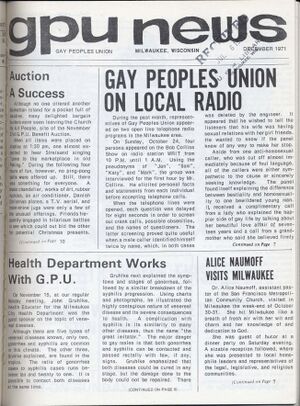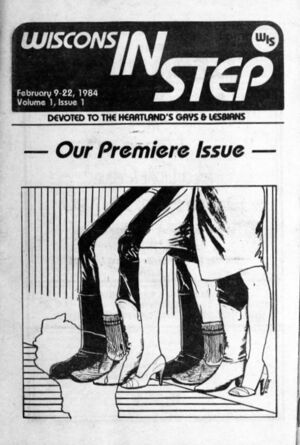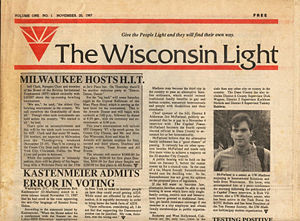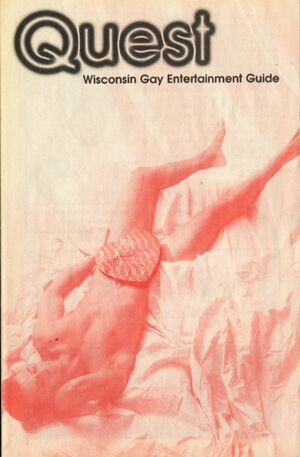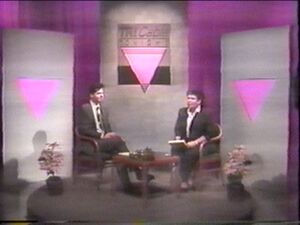Wis. LGBT History-- Media
title: Wis. LGBT History-- Media
MEDIA in Wisconsin's LGBT History
Wisconsin is fortunate to have had a wide range of positive media coverage and media outlets, starting in 1971. In that year, the "GPU News" was founded- a magazine format publication that, during the 1970's, was nationally and even internationally sought after and recognized. Published from 1971 to 1981, the Wisconsin LGBT History Project website has had representative pages of each issue available for viewing on-line for nearly 4 years. (Party due to this effort, the University of Wisconsin recognized the groundbreaking value of the publication in the nation's LGBT history, and has subsequently digitized every page of every issue; they are now available on the UW web site as well.)
Virtually every year since 1971, Wisconsin has boasted at least one, and often several, publications devoted to the gay and lesbian lifestyle and interests in the state. The Wisconsin LGBT History Project website has posted a "cover gallery" of the covers of page-1's of every issue we have been able to obtain, and we continued to scan a large number of pages from every issue as well, and posted them on-line for anyone to view. An ongoing project is to "index" the contents in at least some form. Over time this effort will enable us to locate any article and photo of events, celebrations, organizational meetings, bars, sports teams, drag shows, etc. ever published by LGBT print media throughout Wisconsin. (Thousands of these are already scanned and images posted, but are awaiting indexing.)
Some of the publications published for the Wisconsin LGBT community (most represented with cover scans and other images on the web site) include:
- GPU News (1971-1981)
- Amazon (1972-1984)
- Milwaukee Gay Guide (1977)
- Milwaukee Calendar (1978-1981)
- Leaping LaCrosse News (1981-1997)
- Our Horizons (1981)
- Escape (1982-1983)
- Out! (1982-1987)
- Ragg (1983)
- Wisconsin In Step (1984-2003)
- Among Friends (1986-1989)
- Wisconsin Light (1987-2002)
- Steam (1993-1994)
- Uptown Downtown (1993-1994)
- Quest (1994-date)
- Q-Voice (1995-1998)
- OutBound (2002-present)
- Edge (2003-2006)
- Queer Life News (2004-2008)
- Our Lives (2007-present)
- Wisconsin Gazette (2009-present)
In addition to representative scans of virtually every LGBT publication ever published in Wisconsin, the http://www.WisconsinGayHistory.org web site also documents how the state has been represented in national "Gay travel" guides from 1969 to the mid-1990s.
PRINT MEDIA:
GPU News
Milwaukee (1971-1981)
The Gay Peoples Union (GPU) was founded in 1971 as a social service agency dedicated to the needs of the gay community, and concurrently dedicated to educating the community at large about gays and lesbians. Its genesis was actually the Homosexual Freedom League at UWM, which become a non-university organization called the Gay Peoples Union.
Early on, the GPU had a weekly radio program (one of the first regular gay/ lesbian radio programs in the nation) and a newsletter (the Milwaukee Update). The monthly periodical (GPU News) was started to help document the subject matter and contents of the radio program's discussions, and quickly attracted a wider circulation with its collection of news, stories, advertisements for local and regional businesses, etc.
At first, GPU News was primarily Milwaukee based and focused, and published without copyright. However, within a few years the publication became nationally known and widely recognized as containing superior editorial and fictional content in a broad range of interests to the gay and lesbian community. In its heyday (the mid-late 1970's), the magazine received wide acclaim, every issue featuring "letters to the editor" from people around the country, complimenting the publication and its content. It began to publish with a copyright, held by Liberation Publications in Milwaukee.
Unfortunately, late in 1980 the magazine's volunteer base to compile and lay out the publication was severely compromised; and with regret the publisher, Eldon Murray, announced that the January, 1981 issue (volume 10 number 4) would be the last.
In Step
Milwaukee (1984-2003)
The premiere issue of Wisconsin IN Step, first called WisconsIN Step, rolled off the presses on February 9, 1984. The issue was 48 pages long and five thousand copies were printed in a 5-1/2” x 8-1/2” newsprint format. Until its sudden demise, after several physical transformations but just one major ownership change, Wisconsin IN Step - popularly known through all of its incarnations as just "In Step” - was the longest running, continually published gay and lesbian newspaper in the state.
In Step was the brainchild of David Iraci and Ron Geiman, who, after their stints in the Marine Corps and Army in the 1970s, became involved in Milwaukee’s gay community. In the early 1980s, a series of gay papers and entertainment guides started and folded in very short order. Geiman sold ads for two of those publications, Escape and Gay Milwaukee, but local businesses were reluctant to advertise because the owners and publishers were based in Chicago. Geiman became convinced he could win local advertising support for a locally run newspaper, and In Step was born.
The growth of In Step mirrored the growth of Wisconsin’s LGBT community. The “Guide” in the first issue of “WisconsIN Step” included just 40 listings, all of them gay bars in Wisconsin or bordering states. By the 1990s, IN Step published between 80-96 pages biweekly and its Guide included hundreds of gay and lesbian-owned bars, restaurants and businesses, political organizations, choruses, churches, sports teams, services and support groups.
IN Step documented the Milwaukee and Wisconsin LGBT communities' victories and losses - civil rights laws, Supreme Court decisions, the Gay Games, the Pentagon’s policy, Jeffrey Dahmer’s crimes, Tammy Baldwin’s election to Congress, Stonewall 25, gay bashings, gay weddings and, of course, AIDS. The very first issue in 1984 reported that the Centers for Disease Control counted 3,064 cases of AIDS nationwide, while the toll in Wisconsin at that time was just 24.
Advertising and content increased to such an extent that in 1993 Ron Geiman “took the leap,” as he says, and expanded In Step’s format. In December of that year, it appeared in an 8-1/2” x 11” standard magazine format, though still on newsprint. And in deference to the more inclusive spirit among gays and lesbians, it was dubbed “In Step: Wisconsin’s LesBiGay Magazine.”
But further changes were on the way. When Geiman became ill in 1995, Jamakaya served as editor for an interim period until the paper was sold. In April of 1996, William Attewell and Jorge Cabal purchased In Step. Together, they had begun publishing a gay magazine, Q•Voice, in October, 1995.
In May of 1997, the annual Pride issue was published in a new format - a tabloid-size newsprint edition with a banner reading: “In Step Newsmagazine.” Then, in August of 1998, Q-Voice was merged into In Step, with the letter “Q” retained to mark the paper’s arts and entertainment section. In November of 1998, In Step began bearing the subtitle “Wisconsin’s LGBT Community Newspaper.” A final transformation took place in January of 2000, with a bold new logo that reaffirmed the paper’s geographic market while honoring its roots: “Wisconsin IN Step.”
In Step's last issue was dated November 20, 2003- although at the time no one knew there was to be no next issue. Contributing staff had even been preparing articles for the next issue that never came about. The publisher is reported to have lost interest in the paper and it became more of a chore than a pleasure or passion. Although a last "wrap up" issue was promised, none ever appeared.
Wisconsin Light
Milwaukee (1987-2002)
The first issue of Wisconsin Light appeared on Nov. 20, 1987 under the direction of Publisher Jerry Johnson and Editor Terry Boughner. The front page banner included the motto: “Give the People Light and they will find their own way.”
The premiere issue indicates that Wisconsin Light was initiated as a direct successor to OUT, a small monthly newspaper based in Madison which had ceased publication that summer. IN Step, in a small "bar rag" magazine format at that time, was primarily covering the bar scene, and many activists felt a need to launch a new publication that would include a fuller array of news and commentary. Ron Geiman, publisher of IN Step, supported the effort.
The first issues of Wisconsin Light came out monthly, but by the spring of 1988, in hopes of raising more advertising revenue and accommodating the increasing volume of news copy by and about gays, a decision was made to publish bi-weekly. This the Light did consistently until March of 1999, when it went weekly.
High water marks for Wisconsin Light during its history include its extensive coverage of the Jeffrey Dahmer case in 1991-92. The Light published an “Extra” edition on Aug. 1, 1991 to provide timely information on many aspects of the mass murder, which had a dramatic impact on the city’s gay and lesbian community. The Light scooped the mainstream media with information on some of Dahmer’s victims and past evidence of Milwaukee police officers’ harassment and insensitivity to gays. The Light’s coverage of the Dahmer case won awards from the National Gay and Lesbian Press Association.
On Nov. 6, 1997, Wisconsin Light published a 120-page anniversary issue called “A Decade of Light.” It included a massive timeline of all major LGBT events-- local, statewide and national-- that had been reported in the Light since its founding, along with hundreds of photos of those events, most taken by Jerry Johnson. It stands as the most thorough history ever compiled of that 10-year period of LGBT life in Wisconsin.
In June of 1998, Johnson and Boughner sold the Wisconsin Light to Greg Quindel and another unnamed investor. At the end of 1998, Light announced that the newspaper would begin publishing weekly. Its first weekly issue debuted in March, 1999. But exactly one year later, the Light published its final regular issue. (The Wisconsin Light newspaper was resurrected briefly late 2001, but ceased publication again after just a few months.)
Quest
Green Bay (1994-present)
Quest was founded by Mark Mariucci of Green Bay to give equal treatment to businesses, bars, organizations, etc. throughout the state of Wisconsin. Originally primarily a calendar, directory, and advertising venue (dismissed by some as a 'bar rag', and subheaded "Wisconsin Gay Entertainment Guide"), Quest evolved over time into an important community resource for news and community happenings, especially after the demise of both state LGBT newspapers: In Step and Wisconsin Light. During 2003-2004, the magazine was subheaded "Wisconsin's Source for LGBT News & Entertainment".
In 2006 the owner purchased the rights to OutBound magazine from that magazine's publishers, who were moving out of state. Mariucci continued to publish both publications, with OutBound concentrating more on bar events and calendars, and Quest covering more of a news, articles, and analysis role.
Quest recently began its 17th year of publishing. It has maintained a balanced coverage of news and events statewide throughout its history, although it wisely adjusts news content based on the existence (or non-existence) of other GLBT news media in the state. It has however excelled in coverage of the Drag and show scene, which many other publications covered sparsely.
BROADCAST MEDIA:
Gay Perspectives
Milwaukee radio (1971-?)
A weekly radio show was started in Milwaukee in 1971. Called "Gay Perspectives", it was one of the earliest and longest running regularly scheduled gay-themed shows in the nation. Select segments have been recently discovered, and are being restored and transcribed by the Archives Department of the University of Wisconsin- Milwaukee.
"Some Call Them Gay"
Milwaukee television (September 1973)
From September 24 to 28, 1973, television station WTMJ-TV in Milwaukee broadcast a five-part series on the city’s gay and lesbian community. The series, shown during the noon and 10 p.m. newscasts, was titled “Some Call Them Gay.” The relatively unprejudiced and objective representation of gay men and lesbians was remarkable for mass media of this period. The Milwaukee Press Club recognized “Some Call Them Gay” as the Best Television Documentary or Series of 1973 and praised “the quality of reporting and the sensitivity used on a subject so controversial in nature.” All five segments are preserved in the news film archives of WTMJ-TV, which is administered by the Archives Department at the University of Wisconsin--Milwaukee, and have been shown at several PrideFest celebrations on large screen TV's in the History Project tent.
Tri-CableTonight
Milwaukee cable (1987-1992)
The Milwaukee Gay/Lesbian Cable Network consisted of a small group of extremely dedicated individuals who wanted to use the newly available cable network franchise's public access facilities to produce a regular program on gay and lesbian issues. The two Executive Producers, Mark Behar and Bryce Clark, approached the Cream City Foundation Board in late 1987 seeking funding of that programming: mostly the cost to duplicate tapes, and other miscellaneous expenses. As a result, and in order to provide on-going funding, the CCF invited the Cable Network to operate as a subcommittee of the CCF.
The 30-minute programs were produced monthly (with a few exceptions), each show broadcast about 3 times a month on Warner Cable channel 14. The magazine style format covered an average of 6 to 7 segments in the half-hour time drame, and featured tight directing and split second transitions from one segment to another. The programs were a combination of in-studio news presentaions, interviews, and discussions, plus segmnents tapes out in the community at various events or venues. There were also occasional call-in segments.
A favorite segment of many shows was "GayStory", narrated by Dr. Terry Boughner. These segments featured historical overviews of gay and lesbian life and people. (Dr. Boughner published the book "Out of All Time", a collection of gay and lesbian biographies he wrote, which was published by Alyson Press in 1988.)
Early on, Milwaukee Gay/Lesbian Cable Network won the Cream City Business Association's "Outstanding Community Achievement" award, and several national gay/lesbian press associations asked that tapes be submitted for judging in national contests.
The first anniversary of the program's showing on MATA (Milwaukee Access Telecommunications Authority), brought two surprises. First, the Tri-Cable Tonight programming won the top two awards of the year at a MATA award program: the CCF sponsored group won first place for "Overall Best Regular Series", as well as the award for the "Best Achievements in Minority Programming". The second surprise was the high number of "straight" people calling in to the program's first anniversary special. Most of these people were seeking information to help them understand and deal with cherished friends and relatives who were gay/lesbian.
Over the course of the program, it won several local and national awards. It was the first Milwaukee Public Access TV program to ever win First Place in the national Hometown Video Awards program (in 1989); it was only the 2nd GLBT program to win that award. It also won several First Place local "Philo" awards, sponsored by Milwaukee Access Telecommunications Authority. Overall, this national and local recognition highlighted the pioneering and leadership spirit that may have set the tone for all nationwide GLBT TV/cable programming back in those early days of gay involvement in television production.
The Milwaukee Gay/Lesbian Cable Network also created and broadcast several special hour-long programs, as well as other programs in the early 1990s, including The New Tri-Cable (NTC), and a gay comedy program, "Yellow on Tuesday".
- Return to INTRO page: Wisconsin LGBT History Project- Intro
Explore the full web site documenting GLBT life in Milwaukee, Madison, Green Bay, and all of Wisconsin at: http://www.WisconsinGayHistory.org
Source: The "History of In Step" appeared in that publication's issue 18-11 in May 2001. All other contents of this page copyrighted by Don Schwamb of the Wisconsin LGBT History Project.
